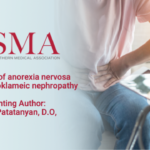Abstract | November 6, 2020
A Rare case of anorexia nervosa leading to hypoklameic nephropathy
Learning Objectives
- Upon completion of this lecture, learners should be better prepared to approach a patient with hypokalemia with identification of possibly etiologies, among which a key discussion point is metabolic alkalosis which requires further breakdown by demonstrating knowledge of diagnostic measures to compare and contrast the differentials under the metabolic abnormality.
Introduction: Although the complications of psychiatric conditions are vast, irreversible kidney damage as the leading cause of death is an infrequent occurrence. There have not been many documented cases that discuss how an eating disorder results in chronic metabolic disturbance due to permanent scarring of the renal interstitum.
Case Presentation: A 27-year-old man with history of anorexia nervosa, depression, anxiety, osteoporosis, and “K+ wasting disorder” presented to ED with CC of cramping in his hands and lower legs. His symptoms began the previous day and gradually worsened. He has had many prior admissions from the ages of 19 to 27 at various facilities with similar complaints, during which he has always shown to have K+ levels <2.0. He was being followed by a nephrologist who had him on a total of twenty-six 20mEq KCl tablets on daily basis.
Vitals:
Pulse 77, Respirations 16,
Blood Pressure 90/58,
Pulse ox 95% on room air,
Weight 51.2 Kg,
Height 72inch,
BMI 15.325
General: Cachectic Adult male lying in bed in no acute distress
Head: Atraumatic, normocephalic
Eyes: PERRLA, no conjunctivae injection
ENT: Oropharynx without erythema, edema, or exudates
Neck: Supple, trachea midline, no lymphadenopathy
Cardiovascular: RRR no rubs, gallops, or murmurs, no carotid bruits, no edema
Respiratory: CTA bilaterally, no rhonchi, wheeze, or rales
Abdominal: Soft, non-tender, non-distended, + BS, no guarding, rebound, or masses
Extremities: Pulses 2+ x4, no clubbing or cyanosis
Musculoskeletal: BUE, BLE Strength 5/5, symmetrical, ROM intact
Integument: No rash, lesion, ulcers
Neurological: A&O x 3; CN II-XII intact
Psychiatric: Affect, Language, Behavior appropriate
Key laboratory findings: K+ 1.7mmol/L (Baseline 2.5mmol/L), Mg levels 2mg/dl (Baseline2.0) , CO2 > 45 mmol/L (Baseline >45). ABG demonstrated severe metabolic alkalosis at pH 7.63, pCO2 74, pO268, HCO3 77.8
UA- pH 8.0, Specific gravity <1.005, Protein, Glucose, Ketones, Bili, Leuk esterase, Nitrite all negative
Urine Osmolality 151, Urine Na random 28, Urine Cl random 29, Urine K+ random>180, Urine Calcium random 21, Urine Cr random 52, Ur Cr:Ca 0.4 (indicating hypercalciuria)
Final Working Diagnosis: Hypokalemic Nephropathy and it’s pathophysiology
Chronic potassium depletion in humans produces characteristic, although nonspecific vacuolar lesions in the epithelial cells in the proximal tubule and occasionally the distal tubule. This abnormality generally requires at least one month to develop and is readily reversible with potassium repletion. However, prolonged hypokalemia (as with surreptitious diuretic use, eating disorders, laxative abuse, or primary aldosteronism) can lead to more severe changes, including interstitial nephritis and fibrosis, tubular atrophy, and cyst formation that is most prominent in the renal medulla. The pathogenesis of these changes is not well understood. One hypothesis that has been documented in experimental animals is that the hypokalemia-induced increase in renal ammonium production described above results in ammonia accumulation in the interstitum. This ammonia can activate complement, which may then damage the tubular cells. The associated intracellular acidosis is a stimulus for cell growth that could account for the cellular proliferation required for cyst formation.
Another possible explanation for renal injury is alterations in growth factors and cytokines in response to hypokalemia. These include vascular endothelial growth factor, insulin growth factor-I, insulin growth factor binding protein-1, angiotensin II, monocyte chemoattractant protein-1, and/or transforming growth factor-beta
Outcome: The uncommon outcome of how an eating disorder lead to irreversible kidney injury which resulted in the death of young 27-year-old patient, lead to the presentation of this unique case study to include hypokalemic nephropathy in the differential of patients with prolonged state of hypokalemia. However, other chronic causes of hypokalemia such as Barrtter syndrome and Gitelman syndrome must also be properly ruled out prior to establishing the diagnoses of hypokalemic nephropathy.

